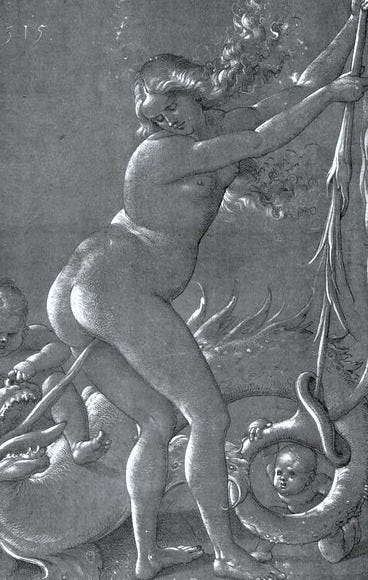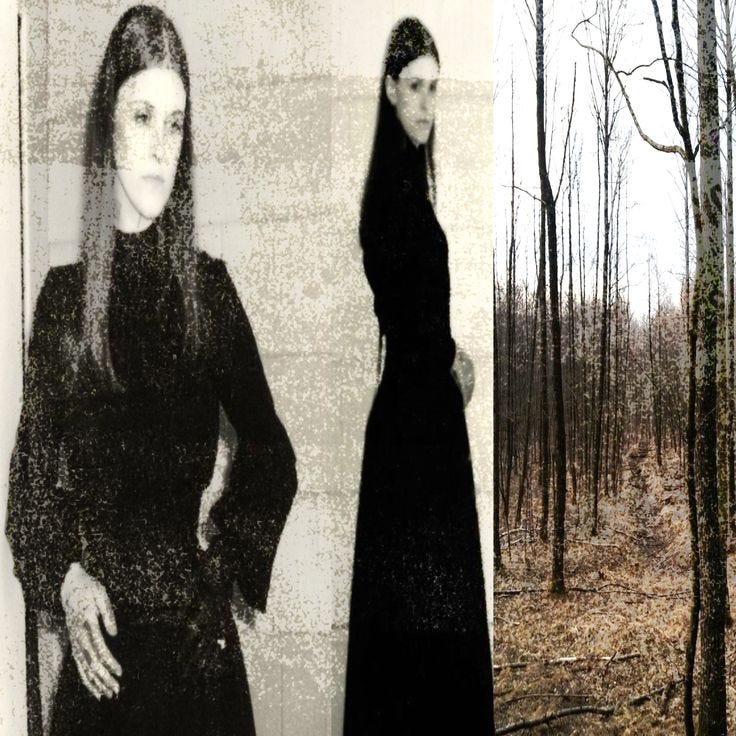the literary function of cannibalism
skin, flesh, borders, consumption: cannibalism and cultural emotion: its more than all-consuming love.
while i’ve always wanted to make cannibalism the topic of one of my zines, i never knew where to start. fortunately for me i have been assigned sarah ahmed’s cultural politics of emotion for tutorials several times and have much to say, specifically from her chapters: “the performativity of disgust,” and “the organization of hate.” so i’m starting here: disgust, hate, intimacy, and eating people.
hate and intimacy; disgust and sensuality; not opposite or mutually exclusive concepts. ahmed posits that the organization of hate and the performativity of disgust help maintain the border between the ‘us’ (the subject) and ‘them’ (the object/ the other); but i want to explore the possibility of this border being transgressed, the existence of a liminal space wherein disgust and hate exist in tandem with sensuality and intimacy.
the fear of “contamination,” is otherwise a fear of the crossing of borders; the fear of something “invading.” in a cultural context, othered bodies stand in for contaminants: ahmed exemplifies an excerpt from charles darwin, wherein darwin’s disgust of a native person touching his food demonstrates that the white man’s fear of contamination lies not in the belief that the native person was “dirty,” but the belief that the native person embodies all that the white man is not: in this way the native person is not made dirty, but is made dirt itself by darwin’s perception. darwin’s disgust lies in that he feels he is ingesting the Other in ingesting food touched by the supposed Other: the root of the fear is that the contaminant will get-in, will pollute the body of the white man.
darwin’s disgust also operates on an association with sensuality: he notes the native man’s nakedness, something that further threatens to transgress a border. the implied proximity and fear of contact of the naked native man as opposed to the clothed white man. darwin’s disgust operated on the fundamentals of hate. darwin (the subject) felt a disgust-induced rage towards the object, the thing that is “not-us.” hate operates on a binary that posits a subject, or the “i/we/us'“ against an objectified Other- the “them”. darwin’s disgust is driven by a sense of violation of the subject’s body (his body). hate, according to ahmed, relates to the body because it is framed in the subject's mind as a potential violation, a threat, a fear of injury.
we view the “us” versus “them” as an objective truth with a concrete border dividing the two, but ahmed’s theories on the performance of disgust imply that this border is much more fragile, and that disgust/sensuality and hate/intimacy simultaneously exist in one transitional space.
before we get direclty into cannibalism, i wanted to look at blood, feeding, and fantasy— the systematic othering of “inferior” bodies through the construction of disgust through these motifs.
leviticus 15, 3-31: “when a woman has her menstrual flow, she shall be in a state of impurity for seven days.”
menstruation was historically interpreted as a confirmation of the supposed “wrongness” of the woman’s body, as opposed to the inherent correctness of the man’s. the expulsion of “wrongness,” from the women's body paired with the idea of the “wandering womb,” provided reason to believe that women’s emotions were guided by their wombs. women were considered to be inherently carnal beings, lacking self-control and driven by lust; thus, evil by nature. serpent imagery relates to this idea: the snake that tempted eve in the garden of eden went on to become a symbol of female carnality. engravings of witches from the 1500s in europe cultivated a weaponized disgust against “deviant” women. the engraving below implied that the intimacy shared between woman and chthonic serpent gives them a likeness that sets them apart from the cultural normative (in this case, men). the “witch” in the engraving is shown nourishing a dragon with her menstrual blood. the deviant woman then becomes a contaminant to the body of society as a whole.
hans baldung grien, witch and dragon, 1515
“Threading the blood through the apple/ Eve sucked the juice from the apple/ nakedly running I saw her/ boy chasing after to stall her/ I wish I’d have spoken to call her/ before she found fabric to shawl her/ breasts bound and burdened with fiber/ Adam came trembling beside her/ and he said, and he said/ that she has the poison inside her/ she talks to snakes and they guide her/ she has the poison inside her.”
sparrow, big thief
blood connotes themes of both ancestry and pollution. the “threading” of the blood “through the apple,” reflects the construction of an eve-based feminine genealogy, wherein eve is the ancestral origin of all women, and thus her sinful nature is present within all women (aside from mary).
the act of eating the apple is framed, in the bible, as a lust for knowledge; she inherits an awareness that her nakedness makes her a carnal body, makes her sinful. flesh evokes disgust and shame.
adrienne lenker’s skillfull weaving of language creates lyrics embedded with human empathy and forgiveness towards eve. the story unfolds with the sensuality with which eve actions combined the voyeuristic implication of someone watching; the frantic binding of the flesh with clothing (once again; the framing of skin as a border and the implication of clothing as a means of containing the contaminant),and finally, the repeated connection between snakes and poison implying that eve, as the first woman and thus all women, is inherently polluted and interlinked with the chthonic.
as ahmed states, there is a connection between those we assign to be “lower” in society and the lower (sexual) regions of the body; the subject sees themself as being pulled downward by the object: adam pulled into sin by eve (i.e. the fall). Eve, the Serpent, and Adam as Death frames eve as the contaminant, poisoning Adam. she, the serpent, and adam are interwoven, but adam is the effectively contaminated one; his skin, that border, is completely gone. this is a visual confirmation of the body being “reformed in the encounter.”
thus we find an intersection of hate and disgust; intimacy and sensuality. the (supposed) pollutedness of women, their uncontrollable carnality, and their susceptibility to the devil came together to construct a narrative of fear, which in turn, constructed a narrative of hate.
proximity and contact are malleable in this situation: to be touched vs. to be the toucher (to fuck versus to be fucked). the fear/hate of others once again stems from that subject/object; injurer/injured dichotomy. the body (of man; of the state) is at threat of being injured and furthermore being invaded (penetrated)/contaminated. this delves into an entirely other discussion of homosexuality and hegemonic masculinity that i won’t get into now.
symbolic cannibalism
i’ve spent some time now constructing intimacy through the lens of hate and disgust. but that doesn’t decomplicate the relationship between intimacy and love. symbolic cannibalism in religion, christianity specifically, reshapes the fear of contamination into something that resembles an acceptance or embracement of the consumption of the other. while darwin was scared of/hated the idea of taking the native inside of him by consuming the food touched by that man, christianity presents us with instances wherein the potential for something to “get in” is something that is welcomed: it introduces a sanctity/holiness in consumption, penetration, and suffering. christianity sanctifies the transgression of borders, the welcoming in of something: inhabiting that liminal space becomes something positive. with christ, the consumption of his body and blood through communion is viewed as a way of allowing him to live on through another body. the body’s surface/border is crossed, and by inhabiting another body (through being consumed), the object exists through the subject. it also thus introduces a queered viewing of christ, wherein he occupies a neither feminized nor masculinized body; he nourishes and provides for his followers like a mother. this phenomenon is also present in depictions of christ’s passion and martyrdom, which frames him in a humbly submissive/feminine/eroticized position, as well as the ever-present side-wound imagery, which has been commonly interpreted as the vagina of christ, co-existing with phallo-religious imagery.
but back to the eucharist, which functions in a twofold manner in the context of the first last supper: first, the intimacy of the lover consuming the loved- christ’s loyal followers consuming his “body,” versus the intimacy of the hater consuming the hated (judas). this very dynamic exists within yellowjackets: shortly before consuming the body of her best friend, jackie, shauna eulogizes her: “i don’t know where i end and you begin.” their friendship is already homoeroticized to such an extent that the border between selves hardly exists, but when shauna takes jackie in, literally, by consuming her, the border ceases to exist altogether; shauna carries jackie within her, and we can see this in the way shauna fails to grow into her adulthood, existing in the body of a 40-something year old woman, yet carrying on like a teenager. it is not lost on me that shauna’s relationship with her own daughter is so strained because she exhibits jackie’s mannerisms, haunting shauna. love can easily morph into resentment and hate when growth and change are stunted.
in strangers, ethel cain asks, “if i’m turning in your stomach am i making you feel sick?” as her lover/abuser murders and cannibalizes her: there is an implication of a mutuality here: the character of ethel cain believes she is loved by the abuser (“isaiah”) but as the story/album progresses we see that she has, time and time again; has become nothing more than a body.
the taking-in of her; the consumption and ingestion, turns her into a contaminant. she will exist within the body of isaiah, and her words imply that she will haunt him, both literally in existing within his body, and figuratively through guilt. cain explores this further in a song titled an ode to eaters, inspired by luca guadagnino’s bones and all (2022).
the holy side wound of christ, from the prayer book of bonne of luxembourg, 1349
allegorical cannibalism
from ode to eaters: “eat of me baby, skin to the bone/ body on body/until i’m all gone/ but I’m with you, inside.”
in tandem with the theme of the eucharist, the body of the object exists within the subject. in the context of bones and all, cannibalism exists as an allegorical identity, representing queerness. in the fictional world of guadgnino’s film, cannibalism is an uncontrollable aspect of one’s existence. the treatment of desire and consumption thus pairs with themes of sexuality and intimacy. ahmed explores the treatment of othered people as cryptids: the othered “cultural bogey man.” the fear of others crossing a border (of the body, of the state) and disrupting normativity is transcribed into a national fantasy wherein normative culture is under attack. the queer individual is thus turned into a collective monster (a contaminant). guadagnino’s decision to frame this fantastical “monster,” as something that is still human (a cannibal) effectively disrupts this attempt at dehumanizing the “them.” this shot (below) from bones and all depicts that transgression of boundaries: skin on skin. the intimacy of this shot as a precursor to the ultimate act of intimacy between the main characters (maren cannibalizing lee), which shapes intimacy into something necessary for survival. “survival makes us vulnerable in that it requires we let what is ‘not us’ in; to survive we open ourselves up and we keep the orifices of the body open.”
bones and all very effectively aligns with ahmed’s ideas of disgust; cannibalism is sensualized and homoeroticized: i.e. maren cannibalizing a girl at a sleepover; lee cannibalizing a boy after leading him into a cornfield on a different premise; maren cannibalizing lee after they seemingly secure a safe, domestic space; it reflects how bodies are reformed by society as objects of intimacy. queer bodies, specifically. the subject (normative, right-wing society) frames the queer body as inherently sexual and predatory: they weave a narrative that they are coming for your kids, that drag queens are groomers and that teachers are showing kids pornography (queer inclusive sex-ed). in ahmed’s queer phenomenology, she argues that bodies are made other (i.e. bodies are made black, disabled, etc.)
but i would argue that bodies are not made queer, rather, they queerness is made other by being made “deviant”, because the spectrum of human sexuality is so wide and fluid that the subject must flatten it so as not to become the object. queer sexuality thus disgusts the subject: queer people are made into a collective of those that disgust the subject, and become threats to the object in such a way.
but queerness is not defined by the subject, and in fact, the border is once again less-so a firm border and more-so a liminal space inhabited by both subject and object, because there are countless instances of things that supposedly stand in for the normative culture that are distinctively queer.
to return to christ’s side wound: the wound, in taking on a distinctly vaginal look, becomes invitational. we ascribe it the feminine quality of the suggestion of being able to be penetrated. it is an invitation to eroticize and queer the body of christ, specifically the wounds inflicted on him during the passion. on caravaggio’s The Incredulity of Saint Thomas we see the actual penetration, the transgression of the surface of the body. while caravaggio himself was likely queer, the side wound as a whole is indicative of an entire culture’s suppressed queerness, especially when considering that manuscripts such as the one featured above were primarily intended for a literate (male) audience. We are invited to view christ as something penetrable. we are also invited to ascribe quasi-motherly features to him, as i mentioned earlier. he becomes something outside of the binary: christ is penetrable; christ is nourishing (i.e. shepard, motherly to his followers; feeding/healing?); christ is simultaneously completely human (i.e. sinful) and divine (i.e. free of sin); christ thus exists in an in-between wherein he is neither one thing nor the other; thus we can read him as being queered.
i have a lot more to say about cannibalism, but i will leave it with this for now. the interplay between what is disgusting and what is sensual is fascinating, and doesn’t end with christ. when i find the motivation to write more, i plan on examining these ideas in the phenomenon of the act of beholding violence and ethel cain’s preacher’s daughter and her upcoming work, perverts. but for now, this is just a snippet of my many ramblings about cannibalism to come.












amazing work zombiegrrrl <3!!! I love your exploration of all the ways in which people can be consumed and what this means in different contexts. absolutely genius!! also, every day I think about Ethel Cain asking "am i no good?" after being eaten like damn that sits heavy in my heart
this was amazing, you write so well!!